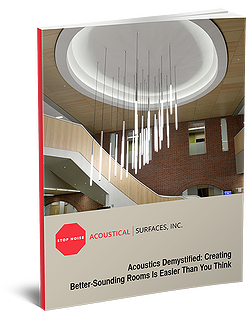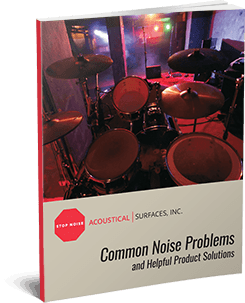Upgrading Noisy, Old Computer Labs: Acoustic Panels & Design Tips
Computer labs have evolved dramatically over the past few decades. Once filled with bulky equipment in plain, utilitarian rooms, today’s school technology rooms and labs have become dynamic, multipurpose spaces designed to support focused learning and collaboration. One thing that remains essential, however, is effective noise management.
Using computer lab acoustic panels to control noise is one of the most effective ways to enhance comfort, focus, and productivity in these modern spaces. Whether your goal is to create a completely soundproof computer lab or simply reduce distractions, sound control must evolve alongside the space.
Common Sound Problems in Computer Labs
Modern computer labs are designed for both individual focus and collaborative work, but without proper acoustic treatment, typical computer room sounds can build up and disrupt productivity. Below are some of the most common sound issues found in computer lab environments and how they impact usability:
Keyboard Clicking and Mouse Sounds
The repetitive clacking of keys and clicking of mice can quickly become a source of distraction in quiet spaces, especially when there are multiple users working at once. In fact, typing noise in shared spaces is one of the most common complaints in open computer labs. These sharp, high-frequency sounds interrupt concentration, particularly for students engaged in reading, writing, or coding tasks.
Fan and Computer Rack Noise (especially in older setups)
Older or poorly ventilated equipment can generate constant hums or fan noise. Server racks or tower units placed within the lab often add to the ambient room noise as well. All this background noise can make it harder to hear instructors or engage in group conversations.
Ambient Sound Buildup in Hard-Surfaced Rooms
Labs with bare walls, tile floors, and low ceilings reflect sound waves, causing reverberation and echo problems. This makes the room sound louder than it actually is, and can reduce the overall acoustic comfort for everyone inside, especially in small or crowded labs.
HVAC or Server Noise Bleeding Into Quiet Zones
Mechanical, electrical, and plumbing (MEP) systems like HVAC ducts and pipes, as well as adjacent server rooms can bleed noise into the lab if not addressed. These low-frequency hums can be distracting over time, making it difficult for students and staff to concentrate.
Poor Speech Intelligibility During Instruction or Group Work
Echo, reverberation, and ambient noise can all reduce the clarity of spoken words. This makes it harder for students to hear, meaning they may miss key pieces of information, have trouble communicating with groups, and often raise their voices to compensate, exacerbating the problem.
Given these challenges, knowing how to cope with lab noise effectively is essential for maintaining a productive learning environment. From behavioral strategies and layout adjustments to technical solutions like acoustic panels and sound masking, there are several approaches to managing noise and improving focus in computer labs.
Why Acoustic Panels are Essential in Computer Labs
With so many potential sources of distraction, it’s critical to invest some time and energy into proper noise control in learning spaces. Noise in labs isn’t just annoying–it impacts concentration, test performance, and even device performance in some sensitive applications.
Reducing sound reflections keeps echo and reverberation in check, lowering ambient noise levels and greatly improving speech intelligibility. Whether students are listening to an instructor, collaborating in groups, or working independently, a well-managed acoustic environment supports their ability to stay engaged. One of the most effective tools in any acoustic design is the acoustic panel, including wall-mounted treatments and lab ceiling panels that reduce sound reflections from above.
Incorporating acoustic panels into your lab design will:
- Absorb mid- to high-frequency sounds like typing and mouse clicks
- Reduce reverberation /echo in the room
- Reduce Distractions caused by speech and equipment sounds
- Improve speech clarity for students and instructors
- Create a calmer, more focused environment
- Help your organization meet the required modern educational standards
Acoustic panels not only enhance functionality, they can also add aesthetic value, making your lab a more welcoming and efficient space for learning and collaboration.
Best Places to Install Computer Lab Acoustic Panels
There are some key places where you can install acoustic panels in your computer lab for maximum effectiveness. Focusing on ceilings, walls, corners, and spaces between workstations helps control both direct noise, like typing or talking, and reflected noise that can echo throughout the space.
Lab Ceiling Panels
Ceilings are often overlooked, but they play a major role in how sound travels and reflects. Installing ceiling systems like acoustic ceiling tiles, surface mounted acoustical panels, hanging baffles, or clouds will absorb sound from conversations, computer fans, and sounds from keyboards and mouse clicks, and will even help silence overhead MEP systems. Ceiling treatments are essential for controlling sound reflections in rooms with hard flooring. One thing to note is that clouds and baffles are best suited in rooms with higher than average ceilings as they will make the ceiling in a space to feel quite a bit lower. Also, it is essential to make sure that baffles and clouds do not affect the throw and coverage of a fire suppression sprinkler system as well as a best practice to put them above lighting or they can cast strange shadows in a space.
Acoustic Wall Panels for Computer Labs
Since hard walls are notorious for reflecting sound waves that contribute to echo and reverberation, mounting panels in corners where sound waves build up and at ear level along side walls or across from workstations will help absorb speech and equipment noise. They can even enhance the aesthetics in the space if you choose the right panels.
Using products like Sound Silencer, Echo Eliminator, PolyMax PET felt panels, or fabric-wrapped fiberglass panels is a great way to add both aesthetic appeal and acoustic performance. Fabric-wrapped panels can even be custom printed with designs of school mascots or logos, boosting school spirit while controlling noise in the lab. The Sound Silencer panels are one of the only acoustical panel options that doesn’t hold an electromagnetic charge – making them IDEAL for computer labs and server rooms or closets.
Acoustic Panels or Furniture Partitions Between Workstations
Adding panels or partitions between rows of desks reduces direct sound transfer and helps contain keyboard noise. These barriers also provide a sense of personal space, which can reduce distractions and improve focus. For multipurpose labs, modular or mobile partitions offer the flexibility to configure the layout without sacrificing acoustic performance.
Upgrading an Old Computer Room for Modern Sound Needs
Many older computer labs were built with functionality in mind but lacked proper acoustic planning. These spaces often feature tile or concrete floors, reflective walls, low ceilings, and little to no sound absorption–all of which contribute to excessive noise and poor speech intelligibility. Understanding the specific computer lab dimensions is crucial for tailoring acoustic treatment plans that effectively address sound reflection and diffusion challenges in each unique space. Fortunately, modern sound needs can be met through thoughtful retrofitting without making major structural changes. Here’s what you can do:
Add Wall and Ceiling Panels
Acoustic panel installation on walls and ceilings is one of the easiest ways to reduce echo and ambient noise. Focusing on ceilings, corners, and wall areas near workstations and along reflective surfaces will deliver the biggest benefit.
Use Sound Masking Systems
In labs that need additional noise control, sound masking systems can help by introducing low-level background noise that reduces the intelligibility of distracting sounds. This is an ideal solution for open labs, testing areas, or spaces adjacent to louder equipment rooms or hallways.
Flooring and Furniture Enhancements
Adding carpet tiles can greatly reduce footfall noise and the noise created by general movement within the lab. Also, using softer seating like upholstered chairs or acoustic furniture can complement your sound strategy while improving overall comfort and usability.
Tips for Bringing Outdated Labs into ADA and Acoustic Compliance
Upgrading acoustic conditions supports compliance with ADA standards, especially for students with hearing impairments or sensory sensitivities. Here are some quick tips for bringing your outdated lab into ADA compliance:
- Improve speech intelligibility
- Support assistive listening devices
- Designate quiet zones
- Control mechanical noise
- Ensure clear communication access
- Use inclusive furniture layouts
More Design Tips for a Quiet, Functional Computer Lab
There are several steps you can take–aside from installing acoustic panels–to create a quieter, more functional computer lab. Designing the space with sound control in mind ensures the layout, materials, and equipment all work together to support a focused, comfortable environment.
Computer Lab Furniture Design
Furniture for labs plays a key role in reducing noise in computer labs. Desks with under-desk sound baffles help absorb noise from typing and movement, while desk dividers between users provide both acoustic separation and added privacy. Choosing sturdy, non-rattling furniture minimizes incidental sounds and creates a more focused, comfortable environment. Together, these elements support a quieter, more effective workspace.
Computer Lab Lighting and Acoustics Integration
Good lighting and acoustics can and should work together. Overhead acoustic panels like clouds or baffles can be installed around or integrated with lighting fixtures to manage sound without compromising visibility. Consider baffled lighting setups that diffuse both light and sound. Avoid noisy fluorescent fixtures, which can hum or flicker and become a distraction in otherwise quiet spaces.
Server and Computer Rack Noise
Servers and older computer racks can generate a lot of fan noise and low-frequency humming. To control this, place loud equipment in a separate, acoustically isolated room whenever possible. If relocation isn’t an option, use acoustic enclosures, soundproof closets, or mass-loaded vinyl (MLV) barriers to contain the noise. For labs with windows facing noisy server areas, acoustic window inserts can further reduce noise bleed.
Read More: Soundproofing for Schools, Universities and Classrooms
Recommended Acoustic Products for Computer Labs
Acoustical Surfaces carries a wide range of ceiling systems and acoustic wall panels for schools. Each option perfectly balances acoustic performance with aesthetic enhancement. Here are some of the most popular computer lab acoustic panels:
| Product | Best For | Custom Printing Available? |
| Echo Eliminator Panels | Applications where budget is more important than aesthetics – and best suited for situations where it can be installed in parts of the room where it won’t see contact. | No |
| PolyMax PET Felt Panels | Instances that need a middle-of-the-road product when balancing aesthetics with budget. Great for direct mounted panels, baffles, clouds and ceiling tiles. | Yes |
| Fabric-Wrapped Panels | When aesthetics are just as important as performance. With custom sizes, shapes, fabric and core options, this is the best looking and most absorptive option. These panels can also be installed as ceiling tiles, baffles or clouds – and tackable panels are available also. | Yes |
| Sound Silencer Panels | Instances where the panels will be installed into parts of the room that will see contact and a bit of abuse. The BEST option for installations near servers or similar equipment as this panel does not hold an electromagnetic charge, is extremely durable as well as washable. Finally, they both absorb AND block noise. | No |
Final Thoughts: Why Sound Matters in Every Lab Setup
No matter the setting–a K-12 school, university, or corporate workspace–acoustics are a critical part of an effective computer lab. While technology often takes center stage, the surrounding environment plays a powerful role in our ability to focus, learn, and collaborate. A thoughtfully designed, acoustically controlled space not only reduces distractions but also supports better retention, communication, and overall wellbeing.
Ready to upgrade your lab? Contact Acoustical Surfaces today for expert advice or to request a quote on computer lab acoustic panels tailored to meet your unique needs.







